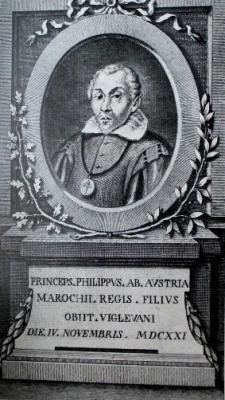Died 1621 | ||
 | ||
Muley Xeque (Arabic: مولاي الشيخ Mawlay al-Shaykh) was a Moroccan prince, born in Marrakech in 1566 and died in Vigevano (Lombardy, Italy) in 1621. Exiled in Spain, he was converted to Catholicism in Madrid and was known as Philip of Africa or Philip of Austria, in addition to the nickname of The Black Prince.
He was the son of Saadi Sultan Abdallah Mohammed, who after reigning between 1574 and 1576 was dethroned by his uncle, Abd al-Malik (1576-1578). Aided by Portuguese troops under the command of King Sebastian of Portugal, al-Mutawakkil faced his rival on August 4, 1578 in the Battle of the Three Kings, which resulted in the defeat of the Portuguese and which killed three monarchs, giving way to the reign of Ahmad al-Mansur, the brother of Abd al-Malik.
After a stay in Portugal, he lived in Carmona from 1589 to 1593. According to Lope de Vega, who was his personal friend and whose comedy "The Baptism of the Prince of Morocco" must be part of what we know about the character, Muley Xeque decided to leave Islam after attending in Andújar to the procession of the Virgin Head.
On November 3, 1593 he was baptized in the Monastery of San Lorenzo de El Escorial, sponsored by Philip II, after whom he was named. He was made a grandee of Spain and Commander of the Order of Santiago.
He was well acquainted with Madrid's high society of the time. He lived in a mansion at the corner of Huertas and Prince streets (which gave its name) in the place currently known as Santoña Palace. His friend, Lope de Vega, dedicated his sonnet 148 to him.
Upon the expulsion of the Moors, the presence of a former Muslim in the court became uncomfortable, so Muley Xeque moved to the Spanish possessions in Italy. There he died in Vigevano, near Milan, where he was allegedly buried, but his exact resting place is unknown. A chronicler of Vigevano, Matteo di Cherasco Gianolio, picked up the eventful life of Muley Xeque in a book called the Vita Memorie storiche intorno the real prince Muley Xeque di Marocco, another of the historical sources on the life of this character.
Muley Xeque is due, and the name of Prince Street in Madrid, Calle Felipe Africa in Valdemorillo, where he lived some time before his baptism. In Getafe, there is another street of the same name, not about Muley Xeque, but another Moroccan prince who, years later, was baptised with the same name.
